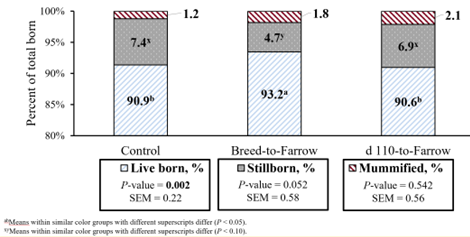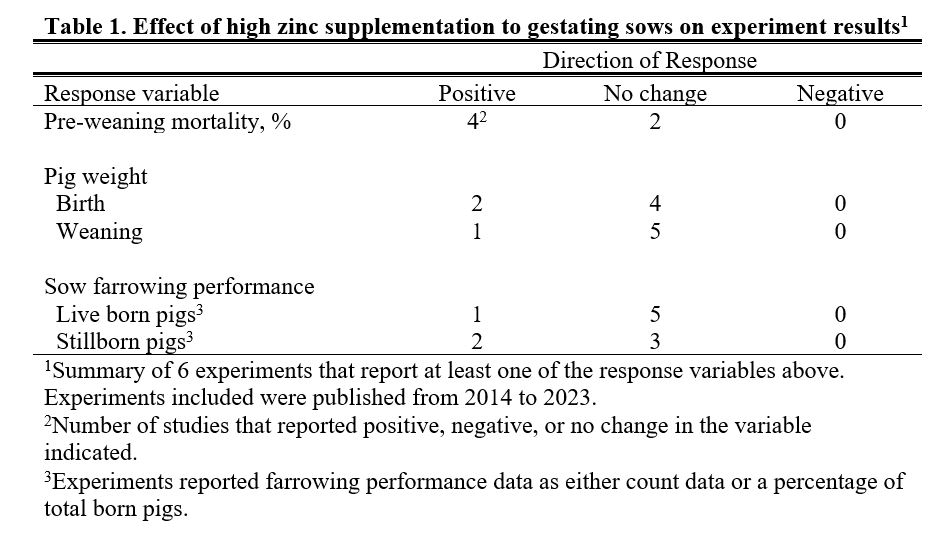By Kelsey Hammers, Pedro E. Urriola, Andres Gomez and Lee Johnston, University of Minnesota; Mark Schwartz, Schwartz Farms; Moon-Suhn Ryu, Yonsei University
In recent decades, genetic selection has allowed for increases in average litter size at birth, however similar increases in pre-weaning mortality has not allowed pigs weaned per litter to rise proportionally. Additionally with large litter sizes, producers have observed an increased incidence of low-birth-weight pigs (greater than 2.2 lb). Pre-weaning mortality rates can range from 8 to 20%, while mortality rates of low-birth-weight pigs can be extremely high around 50 to 80%. Hyper-prolific sows retain more embryos in the uterus than the sow can develop to an acceptable birthweight. As a consequence of this crowding in the uterus, some fetuses are subjected to growth restriction.
An area of interest to decrease competition among fetuses is to utilize fetal imprinting strategies by modifying the diet of the gestating sow. Rapid fetal growth is widely known to start around day 70 to 80 in gestation and this period has been identified as an important time where the sow may require additional nutrients to support fetal growth. Researchers have focused on supplementing the sow in late gestation with certain nutrients such as individual amino acids, increased dietary protein and/or energy, or increased total feed, but these dietary strategies have delivered mixed results. Our group hypothesized that enhanced trace mineral nutrition of the sow, specifically higher dietary levels of zinc, would result in improved piglet survivability.
Initially, our group considered high zinc as a possible fetal imprinting strategy after reviewing the results of Vallet and coworkers (2014) who observed mortality of low-birth-weight pigs decreased with the addition of 453 ppm of supplemental zinc to the diet of gilts starting on day 80 of gestation. This was a small study with mortality rates lower than typical commercial herds. So, we wanted to conduct a study in a commercial setting to determine if the reduction in mortality could be replicated.
Sows were fed 3 dietary levels of zinc (125, 365 or 595 ppm) starting on day 85 of gestation which resulted in a tendency for overall pre-weaning mortality to decrease (15.0 to 12.2%). Just as importantly, mortality of pigs weighing less than 2.2 lb at birth decreased 10 percentage points with the highest level of zinc (38.3 vs. 28.1%; Holen and coworkers, 2020). Mortality of heavy birth weight pigs (> 3.8 lb) was also reduced with the highest dietary zinc amount.
Zinc supplementation starting in late gestation requires additional labor and therefore is not feasible in commercial settings. Our second experiment was conducted in the same sow farm with the objective of modifying the timing of high zinc supplementation that would still reduce pre-weaning mortality of pigs. Treatment diets were designed to mimic high zinc addition to the standard gestation diet or to minimize the supplementation period to a few days before farrowing.
In the study, 267 mixed parity females were used over three consecutive weekly breeding groups and allotted to one of three dietary treatments from about five days after breeding until farrowing. Dietary treatments consisted of: a standard corn-soybean meal gestation diet containing 125 ppm of zinc in the form of zinc hydrochloride (Control); a diet (Breed-to-Farrow) consisting of the Control + 141 ppm of supplemental zinc as zinc sulfate (266 ppm total) fed from five days post-breeding to farrowing; and another diet (Day 110-to-Farrow) which was the Control diet fed from breeding until day 110 of gestation + 2,715 ppm supplemental zinc from zinc sulfate fed until farrowing (2,840 ppm total). Sows assigned to the Breed-to-Farrow and Day 110-to-Farrow treatments received supplemental zinc in their feed drop boxes or in their farrowing stall feeder as a topdress. At farrowing, individual pigs (n = 3,990) were identified with ear tags (LeeO, PrairiE Systems, Spencer, Iowa) and weighed within 12 hours of birth. Pig mortality was recorded throughout the lactation period and pigs were weighed again at weaning.
Feeding high zinc to sows had no noticeable negative effects on sow feed intake or health. Dietary treatments had no effect on litter size (average = 16.3 total pigs born). Overall mortality and the mortality of low-birth-weight pigs was unaffected by dietary treatment. Sows fed high zinc throughout gestation (Breed-to-Farrow) had an increased percentage of pigs born alive compared to sows fed the Day 110-to-Farrow topdress or the Control diet (Figure 1). Additionally, a trend for the percentage of stillborn pigs to decrease was observed for the Breed-to-Farrow sows compared to sows fed the other two dietary treatments. While pre-weaning mortality was not affected by high dietary zinc fed at varying timepoints in gestation; the mortality of pigs during the farrowing process was reduced in this study. It appears high zinc fed throughout gestation made piglets in this study more robust to survive farrowing.
Recently, two abstracts presented at the 2023 American Society of Animal Science Midwest Section Meeting continues to support our hypothesis that high dietary zinc during gestation imprints fetuses in a manner that improves piglet performance. Researchers in Brazil fed mixed parity sows 125 ppm or 625 ppm of zinc in the form of zinc oxide for the duration of gestation or starting on day 80 of gestation. The number of total born, born alive or stillborn pigs per litter were unaffected by dietary treatment; however, pre-weaning mortality was reduced for both high zinc diets (Cony et al., 2023). This group also suggested that high zinc fed throughout gestation reduced maternal and fetal stress during the farrowing process. Unlike our findings, pigs born to sows fed high zinc throughout gestation had heavier weaning weights and weight gain tended to be greater compared to pigs born to sows fed 125 ppm of zinc. Researchers at Cargill also found benefits of feeding elevated zinc to sows. Hu and coworkers (2023) observed increased birthweight and reduced pre-weaning mortality for pigs born to sows fed 380 ppm of zinc (ZnSO4) four days before farrowing until weaning compared to sows fed 120 ppm of zinc.
High dietary zinc fed to sows during gestation appears to have beneficial effects on sow performance and their offspring. Pertinent scientific reports regarding the effects of high zinc supplementation for gestating females are summarized in Table 1. While these studies have varying results, it appears that high dietary zinc fed to gestating swine has utility as a fetal imprinting tool to enhance the performance of pigs after birth. We suggest that high zinc fed in gestation exerts fetal imprinting effects that enhances the pig's robustness during the farrowing process or pre-weaning survivability and growth. However, the optimal timing and level of zinc supplementation must be validated to limit unnecessary fecal zinc excretion.
We appreciate the financial support of the Pork Checkoff through the Minnesota Pork Board, the financial support from USDA NIFA (Grant 2022-00580), and the cooperation of Schwartz Farms, Sleepy Eye, MN.
References:
Cony, B. S. L., E. C. de Araujo, G. Martins, J. Furtado, C. M. Vier, U. A. Orlando, R. Lunedo, D. Perondi, and I. Andretta. 2023.114 Effects of zinc supplementation in gestating sow diets on growth performance of the progeny from birth to market reared under commercial conditions. J. Anim. Sci. 101(Suppl_2):114.
Holen, J. P., P. E. Urriola, M. Schwartz, J.-C. Jang, G. C. Shurson, and L. J. Johnston. 2020. Effects of supplementing late-gestation sow diets with zinc on preweaning mortality of pigs under commercial rearing conditions. Transl. Anim. Sci. 4:519–530. doi:10.1093/tas/txaa010.
Hu, Q., J. Zhao, N. Paton, S. Walston, M. Legall, and M. Newcomb. 2023. 116 Effect of crude protein level and a fermentation product on sow reproductive and piglet performance. J. Anim. Sci. 101(Suppl_2):116.
Hammers, K. L., P. E. Urriola, M. Schwartz, M. S. Ryu, A. Gomez, and L. J. Johnston. 2022. 122 Timing of dietary zinc additions during gestation for improved piglet survival. J. Anim. Sci. 100(Suppl. 2):56-57. doi:10.1092/jas/skac064.090.
Moeller, J., D. Drebes, R. Schmitt, J. Flohr, F. Zarate, R. Moreno, and S. Brake. 2022. The effect of zinc and copper supplementation during late gestation on subsequent farrowing house performance of commercial sows. Proc. AASV Annual Meeting 2022. (Abstr.) doi:https://doi.org/10.54846/am2022/88.
Vallet, J. L., L. A. Rempel, J. R. Miles, and S. K. Webel. 2014. Effect of essential fatty acid and zinc supplementation during pregnancy on birth intervals, neonatal piglet brain myelination, stillbirth, and preweaning mortality. J. Anim. Sci. 92:2422–2432. doi:10.2527/jas.2013-7130.


